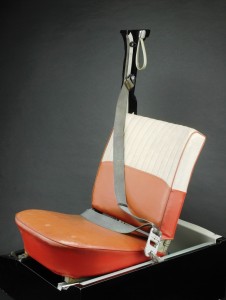
An early seat belt system on a 1961 Volvo PV 544 now on display at the Smithsonian. The Swedish maker was the first to introduce the technology.
More Americans are buckling up than ever before, according to the nation’s traffic safety agency, hitting an all-time record 86% in part due to a significant increase in the South.
The trend towards increased seat belt usage has been credited for the dramatic decrease in U.S. road deaths over the last decade.
“When it comes to driving safely, one of the most effective ways to protect yourself and your family is to use a seat belt,” said Ray LaHood Secretary of the U.S. Department of Transportation, adding that there will be a push to drive the figures even higher during the upcoming holiday season.
While seat belt usage has been mandatory in much of the industrialized world for decades, the U.S. had, at best, a hodgepodge of laws and, in some states, police still cannot issue tickets for failure to use the primary safety device unless a motorist commits another offense. But a growing number of states have turned the violation into a primary offense and have joined in national efforts to get motorists to buckle up.
Every state but New Hampshire now requires adult motorists to buckle up – with that traditionally independent New England state requiring usage for those under 18. Thirty-two states and the District of Columbia now have primary belt laws in effect.
That has had a significant level of success, seat belt usage jumping from just 58% as recently as 1994, according to the National Highway Traffic Safety Administration.
Usage rises and falls, NHTSA noted, The U.S. average dipped to 84% last year, down from 85% in 2010. Michigan reached a peak of 98% in 2009 but that dipped to just over 94% last year.
In the latest study, Pennsylvania saw a 2.2% decline, to just under 84%.
There are regional differences, and the South has tended to have relatively low seat belt usage. But that rose to 85% this year, according to the NHTSA, a 5-point increase from 80% in 2011. Law enforcement efforts appear to have played a significant role in driving motorists to buckle up.
The state with the lowest usage this year is Massachusetts, at 73.2%. Washington State, on the other hand, leads the nation at 97.5%.
The government safety agency estimates that a one percent increase in seat belt usage saves 220 lives annually. NHTSA also credits the simple device with saving more than 72,000 lives between 2005 and 2009 – or about the equivalent of two years of roadway deaths at the current U.S. pace.
Though preliminary data is showing a very slight increase in fatalities during the first half of 2012, U.S. traffic fatalities last year reached their lowest level since 1949, well before the creation of the American interstate highway system.
According to estimates from the National Highway Traffic Safety Administration, 32,310 people died in traffic accidents in 2011, a 1.7% year-over-year decline. That marked the seventh consecutive year that the death rate has declined.
Since just 2005, traffic fatalities have fallen by more than 25% — and when measured in terms of deaths per mile driven the figure has reached its lowest level since record-keeping began in 1921, according to NHTSA.
